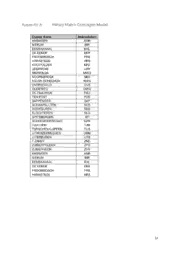
Hazard Assessment for the Eemskanaal area of the Groningen field (deel 2) PDF
Preview Hazard Assessment for the Eemskanaal area of the Groningen field (deel 2)
Figure 43 Hazard map showing the peak ground acceleration (PGA) with 10% average annual chance of exceedance from 2014 to 2017 and the Strain Partitioning seismological model. The contour interval is 0.01g. As a base case peak ground acceleration (PGA) at the location of the Eemskanaal Cluster are 0.29 g, 0.09 g and 0.02 g for exceedance levels 0.2%, 2% and 10% respectively. Annual Exceedance Wipla Prod Restricted Base Level 0.2% 0.34 0.29 0.29 2% 0.11 0.08 0.09 10% 0.03 0.02 0.02 Table 5 Comparison of Hazard Peak Ground Acceleration [fraction of g] for the Reference winningsplan case, the impact of the restricted production plan (5 clusters in Loppersum Area reduced to 3 Bcm) and the base case of this study. 41 Compaction Model Sensitivity Figure 44 Hazard map showing the peak ground acceleration (PGA) with 0.2%, 2 and, 10% average annual chance of exceedance (from top to bottom) from 2014 to 2017 and the Strain Partitioning seismological model. Left column is the Base Case (RTCiM). The right column shows the same assessment, but based on the Time-decay model for compaction. 42 As a base case peak ground acceleration (PGA) at the location of the Eemskanaal Cluster are compared on the table below. Annual Exceedance Level Base Case (RTCiM): PGA (g) Sensitivity Case (TD): PGA (g) 0.2% 0.29 0.33 2% 0.09 0.09 10% 0.02 0.02 Table 6 PGA (g) at the location of the Eemskanaal Cluster for the Compaction Model Sensitivity. 43 Production Sensitivity 44 Figure 45 Hazard map showing the peak ground acceleration (PGA) with 0.2%, 2 and, 10% average annual chance of exceedance (from top to bottom) from 2014 to 2017 and the Strain Partitioning seismological model. Left column is the Base Case (8 mln Nm3/day average monthly production). The top right column shows the same assessment, but based on a 5 mln Nm3/day average monthly production, while the bottom right column shows the same assessment, but based on a 3 mln Nm3/day average monthly production. 45 As a base case peak ground acceleration (PGA) at the location of the Eemskanaal Cluster are compared on the table below. Annual Exceedance Base Case (8 mln Sensitivity Case (5 mln Sensitivity Case (3 mln Level Nm3/day): PGA (g) Nm3/day): PGA (g) Nm3/day): PGA (g) 0.2% 0.29 0.29 0.29 2% 0.09 0.09 0.09 10% 0.02 0.02 0.02 Table 7 PGA (g) at the location of the Eemskanaal Cluster for Production Reduction Sensitivity. 46 Sub-surface Model Uncertainty Figure 46 Hazard map showing the peak ground acceleration (PGA) with 0.2%, 2 and, 10% average annual chance of exceedance (from top to bottom) from 2014 to 2017 and the Strain Partitioning seismological model. Left column is the Base Case (sub-surface model 1; STR40). The right column shows the same assessment, but based on sub-surface model 2 (STR38). 47 As a base case peak ground acceleration (PGA) at the location of the Eemskanaal Cluster are compared on the table below. Annual Exceedance Level Base Case (Model 1): PGA (g) Sensitivity Case (Model 2): PGA (g) 0.2% 0.29 0.33 2% 0.09 0.11 10% 0.02 0.03 Table 8 PGA (g) at the location of the Eemskanaal Cluster for the Sub-surface Model Sensitivity. 48 Conclusions § The Eemskanaal Cluster is located at the western periphery of the field and produces higher calorific gas. This gas needs to be blended to sales specification. Due to the larger sub-surface uncertainty at the periphery of the field and the blending requirement forecasting production from the Eemskanaal Cluster and compaction/subsidence in the Eemskanaal area is challenging, § Using the sub-surface model from the Winningsplan 2013 as a base, the History Match for the Harkstede block (produced by EKL-13) has been improved. Two reservoir models capturing the main sub-surface uncertainty (aquifer influx) have been prepared in support of the Hazard Assessment for the Eemskanaal Area. § For the improved reservoir models, the impact of the compaction model on the hazard is limited. § Similarly, the impact of the production level of the Eemskanaal Cluster on the hazard is limited. § The impact of the selected improved reservoir model is reflected in a moderate uncertainty in the hazard assessment, mainly to the west of the field. 49 References 1. NAM (Jan van Elk and Dirk Doornhof, eds), Technical Addendum to the Winningsplan Groningen 2013 Subsidence, Induced Earthquakes and Seismic Hazard Analysis in the Groningen Field, http://www.rijksoverheid.nl/onderwerpen/aardbevingen-in-groningen/documenten-en- publicaties/rapporten/2014/01/17/bijlage-1-analyse-over-verzakkingen-geinduceerde- aardbevingen-en-seismische-risico-s.html 2. NAM (Jan van Elk and Dirk Doornhof, eds), Supplementary Information to the Technical Addendum of the Winningsplan 2013, http://www.rijksoverheid.nl/documenten-en- publicaties/rapporten/2014/01/17/toelichting-op-gewijzigd-winningsplan-groningenveld.html 3. TNO 2013 R11953 | Eindrapport - Toetsing van de bodemdalingsprognoses en seismische hazard ten gevolge van gaswinning van het Groningen veld. http://www.rijksoverheid.nl/onderwerpen/aardbevingen-in-groningen/documenten-en- publicaties/rapporten/2014/01/17/toetsing-tno-van-de-bodemdalingsprognose-en-seismische- hazard-tgv-gaswinning-van-het-groningen-veld.html 4. Update of the Winningsplan Groningen 2013. http://www.rijksoverheid.nl/documenten-en-publicaties/rapporten/2014/01/17/winningsplan- groningen-wijziging-2013.html 50
